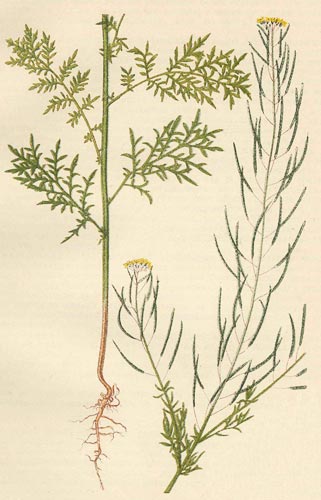Weeds
Descurainia Sophia (L.) Webb. ex Prantl.- Herb Sophia.
Synonyms.
Sisimbrium Sophia (L.)Systematic position.
Family Brassicaceae Burnett (Cruciferae Juss.), genus Descurainia Webb. et Berth.Biological group.
Spring annual weed, able to develop as wintering weed.Morphology and biology.
Plant is 20-75 cm in height, grayish due to short branched pubescence. Stem is upright, bulgy-branched. Leaves are twice or three times pinnatipartite, with oblong-lineate, pointed, sometimes gashed lobes, the lobes are plumpish in plants growing on solonetzic soils. Racemes are multiflorous, elongating at fruits. Petals are pale-yellow, oblong, about 2-2.5 mm in length. Sepals are 2-3 times shorter than peduncles, longer or the same length as sepals. Silicles are upward directed, slightly curved upwards, glabrous, slightly flattened, knobby, 1.5 times as long as horizontal thin peduncles. Silicle valves have three longitudinal ribs and partition wall with net of ribs. Seeds are oval, slightly compressed from sides. Seed surface is yellowish-brown, covered with very small knobs, with yellowish-white spot in the middle of its blunted base. This plant flowers in May-July, bears fruits in June-July. One plant produces from 6000 up to 110000 seeds, maximum productivity is up to 700000 seeds. Seeds begin to germinate at 2-4°C, optimum temperature of germination is 10-16°C, at higher temperatures the seeds germinate worse. Seeds germinate at soil surface or from depth of no more than 2 cm, their germination capacity keeps for no less than 4-5 years. Seedlings appear in spring and in August-September, summer and autumn ones overwinter well.Distribution.
Cosmopolite in moderate zone of Northern Hemisphere. Within the Former Soviet Union it occurs everywhere except arctic regions. General distribution: Europe, North Africa, West Asia up to India and Tibet, China, Mongolia, as adventive plant in North America.Ecology.
In northern parts of its area Descurainia Sophia grows as spring plant, i.e. its seedlings appear in early spring, in south it grows more often as winter plant, and its seedlings appear in autumn and overwinter. This weed prefers light and dry soils, rich in nutrients, sandy or stony ones. In years with wet autumn it can develop in masses in winter crops. Seeds of Descurainia Sophia shatter in the field, consequently, soil is the main source of crop infestation with this weed. Seeds are disseminated with water, wind, and manure. While wet, seeds are sliming, and sticking with mud to passing animals and vehicles; they can be disseminated by that way as well. In thin crop stand Descurainia Sophia is able to develop in masses, totally choking up the crops.Economic significance.
D.Sophia infests various winter and spring crops, fallows, it is found in abandoned places, along roads, near houses, in gardens and vegetable gardens. As a weed D.Sophia occurs more often in forest-steppe and especially steppe zones of European part of the Former Soviet Union, as a ruderal plant it is usual in the Caucasus and submontane regions of Central Asia. Control measures include proper crop rotation - winter wheat cannot be grown for two years in a row in the fields infested with this weed, deep plowing of fields for winter crops, harrowing, autumn plowing, shallow plowing, eradication of weed in uncultivated lands.Related references.
Lenkov, P.V. 1932. Seeds of field weeds from European part of the USSR. Moscow-Leningrad: State Publishing House of Kolkhoz & Sovkhoz Literature. 320 p. (in Russian).Keller, B.A., ed. 1934. Weed plants of the USSR. V. 3. Leningrad: AN SSSR. 448 p. (in Russian).
Komarov, V.L. & Bush, N.A., eds. 1939. Flora of the USSR. V.8. Moscow-Leningrad: AN SSSR. 696 p. (in Russian).
Nikitin, V.V. 1983. Weed plants of the USSR flora. Leningrad: Nauka. 454 p. (in Russian).
Ulyanova, T.N. 1998. Weed plants in flora of Russia and other CIS countries. St.Petersburg: VIR. 343 p. (in Russian).
Visyulina, O.D., ed. 1970. Weeds of Ukraine (reference-identification guide). Kiev: Naukova Dumka. 508 p. (in Ukrainian).


